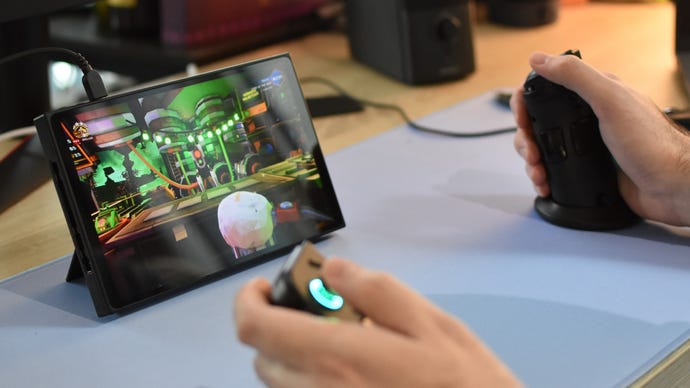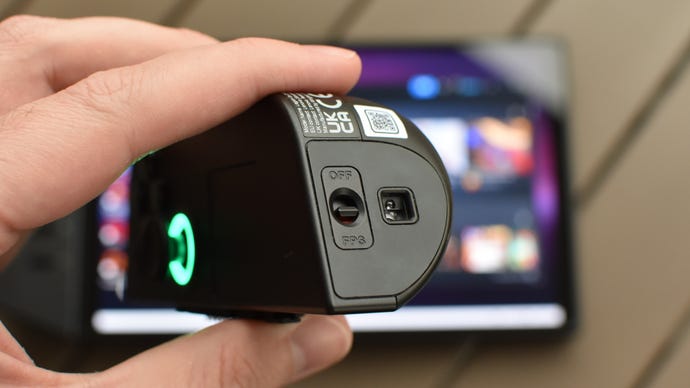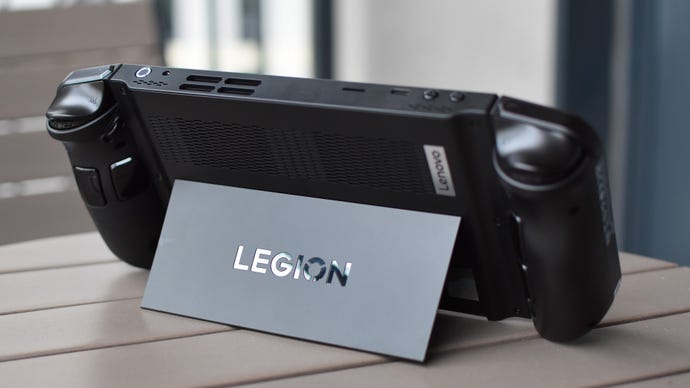It’s been encouraging to see how post-Steam Deck handheld PCs aren’t merely copying Valve’s homework. The Asus ROG Ally made a (principally) profitable try at slimming down whereas upping efficiency, and now now we have the Lenovo Legion Go: an excellent higher-concept moveable with Swap-style removable controllers. One among which transforms right into a mouse. It’s a bit mad however I’ve at all times cherished the idea’s ambition, at the same time as I rendered working protypes rather less… working.
I’m completely satisfied to report that this, the Legion Go’s retail model, is way extra proof against such improprieties. Furthermore, it’s principally the most effective Home windows handheld on the market proper now – although some occasional fiddliness, and the looming situation of the Steam Deck OLED, imply it isn’t essentially the best palmable PC outright.
There’s no arguing in opposition to it having some best-in-class specs. The centrepiece is that honking nice 8.8in IPS touchscreen, which at 2560×1600 and with a 144Hz refresh fee, is kind of a correct gaming monitor that’s merely shrunk within the wash. It’s sharper and sooner than each the Steam Deck OLED and Asus ROG Ally’s screens, and in contrast to each, the accompanying thumbsticks use a Corridor Impact design that retains them (theoretically) proof against dreaded stick drift. These don’t really feel as substantial because the Deck’s comparatively old-timey analog sticks, however they’re grippy sufficient for my lumbering thumbs.
One other massive win over the ROG Ally is the inclusion of a trackpad. Just a bit one, thoughts, not a full pair of huge capacitive pads such as you get on the Steam Deck, however it’s nonetheless sufficient to make navigating Home windows 11 much less depressing than it was on the Asus handheld. Identical goes for the scroll wheel on the again of the appropriate controller – not even the Steam Deck OLED has a type of.
What the Steam Deck does have – OLED or in any other case – is a considerably higher grasp of ergonomics. Though the Legion Go isn’t as heavy because it seems, neither is it as comfortably contoured because the Deck’s grips, and I might acutely really feel the controllers’ extreme edges urgent into my palms after some time. Particularly on the appropriate facet, the place the lowered thumbstick calls for a extra bottom-heavy grip. I additionally want the rear buttons had a tad extra resistance to them, because it appeared relatively too simple to press them by chance whereas repositioning a sweaty/drained palm.
Nonetheless, it’s a tidy bundle total. The controllers really feel stable and safe when hooked up, and the matte plastic is of a better grade than it was on the preview mannequin I examined earlier this yr. And, whereas the kickstand is extra of a necessity than a useful bonus (given it’s important for utilizing the controllers in FPS mode), it’s a lot secure, with a pleasant, agency hinge. You even get a second USB-C port, doubling the quantity that the Steam Deck and ROG Ally discovered room for. A uninteresting spec? Not for those who’re supposed to plug peripherals and different equipment into your handheld PC.
The display impresses as properly. By masking 98.6% of the SRGB color gamut, it’s truly able to displaying a wider vary of hues than even the Steam Deck OLED, so your most vibrant video games will preserve all of their visible pop. It’s primarily distinction and brightness the place the Valve machine wins out, as it might probably attain 984cd/m2 in HDR mode; the Legion Go maxes out at 514cd/m2, although that’s nonetheless sufficient to punch by reflections on the shiny Gorilla Glass.
There’s no ghosting price mentioning, and if you will get a sport working quick sufficient to reap the benefits of the default 144Hz setting, then whacking such a excessive refresh fee on a battery-powered handheld begins making rather more sense. There’s additionally an choice to insta-switch to 60Hz, if you wish to be extra frugal, and the identical quick-access menu additionally affords 1280×800 and 1920×1200 decision toggles.
Admittedly, you’ll virtually positively want these. Whereas it’s good to have the choice of working much less APU-intensive fare on the full, fantastically crisp 1600p, the Legion Go’s AMD Ryzen Z1 Excessive chip all to usually struggles below the load of all these pixels. It normally takes a drop all the best way right down to 1280×800, identical because the Steam Deck, to get clean framerates even on low high quality settings:
And these are simply the video games that would run adequately. Actual powerful’uns like Returnal and Starfield stay fully outdoors the Ryzen Z1 Excessive’s capabilities, even with 800p and FSR upscaling.
Once more, when a sport can run easily at 1600p, it’s nice. Likewise for video games like GTA V that may zoom previous 100fps, a stage of smoothness that’s unattainable on each the 60Hz Steam Deck and the 90Hz Steam Deck OLED. I’d say there’s an excellent stronger sensation of “Wowee, this can be a PC sport working on a handheld” than there may be on the ROG Ally. And but, simply as with that system – which makes use of the very same Ryzen Z1 Excessive APU – you’ll be able to simply find yourself up having to change off the Legion Go’s higher-end options with the intention to merely use it. That’s nonetheless unusual, to me. It’s like shopping for a glistening new 4K monitor then hooking it as much as a knackered GTX 960. Not solely are you paying for specs you’ll be able to’t at all times get pleasure from, however the lack of premium efficiency undermines the entire “You possibly can play something!” message that Home windows-based handheld PCs are at all times eager to push.
In equity, it is extremely good to have all my Sport Cross video games playable domestically, one thing that’s inconceivable on a Steam Deck with out swapping out its total OS. It’s additionally simple admire how putting in launchers like Battle.internet and the Epic Video games Launcher solely requires, y’know, an installer. Not diving so deep into SteamOS recordsdata that you simply come out with black lung. And, while you do must traverse an undersized menu or dialogue field, it’s much more swiftly doable with the Legion Go’s trackpad than with the ROG Ally’s lack of 1.

Not forgetting, in fact, that the Legion Go affords one other approach of bodily enjoying video games totally. One which’s each massively distinct from different handhelds, and virtually comfortingly acquainted to seasoned desktop PC gamers. The 2 detachable controllers might be impressed by the Nintendo Swap, however they’re not for taking part in kart racers with a pal – they, or not less than certainly one of them, is for shifting into an upright mouse, full with adjustable optical sensor (and that dinky scroll wheel). Hate aiming with thumbsticks in shooters? The Legion Go is so determined to be the hand-held for you that it’s keen to allow you to snap chunks off it within the course of.
It initially feels fairly odd, arguably extra akin to an unsecured flight stick than an actual vertical mouse. I received to grips with it will definitely, although, and hey – when it really works, it really works. I used to be definitely extra assured enjoying Workforce Fortress 2 or Deep Rock Galactic with the indifferent controller than I’ve ever been with a hard and fast thumbstick, and even the Deck’s purpose-built trackpads. I’m not saying to enter a Counter-Strike 2 match with it, however with an hour or so’s apply it’s a lot nearer to the texture of a typical gaming mouse than I beforehand would have anticipated from handheld {hardware}.

That mentioned, it’s price remembering the place handheld PCs are principally performed: sofas, bus seats, metro trains, bathrooms. What all these have in frequent is an absence of any sort of secure, flat, clean, adequately sized house on which to each set down the Legion Go and slide its mouse-controller round. Perhaps an airline seat would work, however I definitely wouldn’t wish to try twitchy FPS aiming on a tiny, flimsy, fold-out desk. It’s arduous to see the place the dependable use case is, until you wish to be like the parents within the Legion Go’s launch trailer, misappropriating library tables and taking solo journeys to cocktail bars.
Getting it arrange is barely faffy, too. Greatest case, you need to set your Legion Go down, take away each controllers, put them down, decide the Legion Return up, prolong its kickstand, retrieve the controller base (which comes bundled however free, a significant misplacing hazard), slide the appropriate controller inside it, flip the FPS mode change, and eventually decide up each controllers once more to start out enjoying. Now think about doing all that on a wobbly prepare or in a packed Airbus the place the sozzled scrum-half in adjoining seat already has his elbows midway into your ribs. Not a pleasing thought, particularly when you might go away the entire system as it’s, and get enjoying instantly with thumbsticks.
In case you don’t thoughts rebuilding your handheld, and suppose you may make it work frequently, then by all means go forward and luxuriate in FPS mode. Like I mentioned, I like the hassle to make the Legion Go distinctive, and the practicality is there for those who’re keen to perform a little configuring your self. That extends to the button mapping, too – for all however the easiest shooters, you’ll in all probability must rebind a number of the default inputs. I suppose I can’t assist however suppose it’s nonetheless a reasonably neat characteristic, even when I wouldn’t depend on it a lot myself.

Battery life additionally presents a few nice surprises. One, regardless of the larger, sooner, higher-resolution display, the Legion Go is constantly longer-lasting than the ROG Ally. In Energy Saving mode, with thermals and OS energy each set to Balanced, it saved going for 2h 7m in GTA V and 2h 18in RimWorld; the ROG Ally solely scored 1h 36m and 1h 45m respectively. These had been all on native decision as properly, so the 1080p ROG Ally had a built-in benefit over the 1600p Legion Go.
Granted, Valve’s handhelds are nonetheless prime picks for longevity, particularly in low-demand video games like RimWorld: right here, the unique Steam Deck lasted for 5h 17m, and the extra environment friendly Steam Deck OLED went all the best way to 5h 42m. However the Legion Go pulled an upset within the altogether extra demanding Forza Horizon 5, in some way pulling out 2h 00m lifeless. That bests not solely the ROG Ally (1h 29m) however the Steam Deck (1h 37m) as properly. It’s luck of the draw whether or not you get above or under common battery life, then, however bless it, the Legion Go evidently has an affinity with sure video games. It expenses mighty quick, too. Whereas an hour on the mains would let the Steam Deck reclaim 48% and the Steam Deck OLED 69%, the Legion Go almost will get a full recharge, as much as 96%.
You could be keen to just accept shorter uptimes in change for the Legion Go’s wider sport compatibility over the Steam Deck – a good stance. Be warned, although, that as a lot as Home windows 11 is a identified amount, its nonsense appears to be amplified when it’s been crowbarred right into a handheld. It’s not as unwieldy as on the ROG Ally, thanks largely to that trackpad, however I nonetheless needed to take care of wonkiness that merely isn’t current on the extra tailored SteamOS. Newly put in video games would usually launch within the flawed windowed mode or facet ratio, for instance, or they’d open minimised for no obvious motive. The snap-to-edge system for home windows on the desktop can be far, far too delicate, squishing apps up in opposition to the display’s sides when all I needed to do was shift them a couple of centimetres. Disastrous? No, however you don’t get the it-just-works seamlessness of a Steam Deck.

Fortunately for the Legion Go, it additionally sufficiently distinguish itself to the purpose that it by no means seems like a Steam Deck However Worse. If something, it’s an Asus ROG Ally However Higher: all the flexibleness of Home windows, with barely fewer ache factors, plus a sharper, sooner display, longer battery life, extra connectivity, and a wider vary of inputs. And even when its real-life purposes are restricted, the removable mouse is sweet sufficient to fill a distinct segment.
That’s why, for all of the holes I’ve poked in it – and realizing I’m not going to ditch my Steam Deck OLED for it – I nonetheless just like the Lenovo Legion Go. It will get sufficient of the fundamentals proper, and is bold sufficient with its specs and management scheme that the little annoyances (Home windows performing up) and occasional overshoots (a max decision that numerous video games can’t use) change into much more forgiveable. Or, not less than, simpler to look previous.
This evaluation relies on a retail unit offered by Lenovo.

